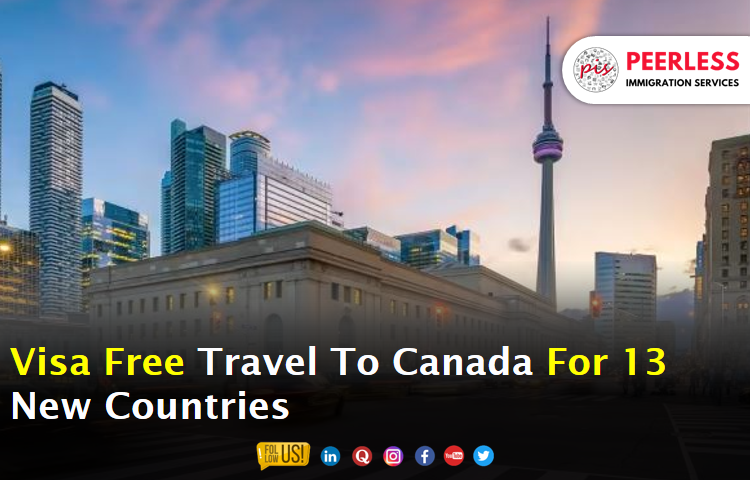
Visa free travel to Canada for 13 new countries
People who want to travel, conduct business, or get together with friends and family frequently choose Canada as their destination.
The Honourable 13 new nations have been included in the electronic travel authorization (eTA) program, according to Sean Fraser, Minister of Immigration, Refugees, and Citizenship. In order to enter Canada by air, visitors from these nations can now apply for an eTA rather than a visa if they have recently held a Canadian visa within the previous ten years or currently possess a valid United States non-immigrant visa.
Which nations can now visit Canada visa-free?
Along with Brazil, there are 13 nations that previously required visas to participate in Canada’s eTA program.
- Antigua and Barbuda
- Argentina
- Costa Rica
- Morocco
- Panama
- Philippines
- Kitts and Nevis
- Lucia
- Vincent and the Grenadines
- Seychelles
- Thailand
- Trinidad and Tobago
- Uruguay
Thousands of tourists will be able to visit Canada for up to six months on business or for pleasure faster, easier, and more affordably with the introduction of visa-free air travel. It will also boost Canada’s economy by promoting greater international trade, tourism, and travel, as well as by improving relations between Canada, and foreign nations while ensuring the safety of Canadians. This choice will also relieve Canada’s immigration burden of thousands of applications, allowing us to process visa requests more quickly for the benefit of all visa applicants.
Existing visa holders may continue to enter Canada using their current documents. Those not qualified for an eTA or entering Canada by a mode of transportation other than an airplane (such as a vehicle, bus, rail, or boat—including a cruise ship) will still require a tourist visa. To find out if they qualify for an eTA and how to apply, travelers can go to Canada.ca/eTA.
THINGS TO NOTE:
- Most visa-exempt visitors must possess an electronic travel authorization, or eTA, in order to enter or transit through Canada by air.
- Canadian officials carry out light-touch pre-travel screening of air travelers using the eTA application. Applying costs CAN$7, and the majority of applications are promptly approved in a matter of minutes.
- Travelers simply require a valid passport, a credit card, an email address, and online access to apply for an eTA. Since the eTA program’s launch on August 1, 2015, about 20.9 million eTAs have been granted.
- In April 2017, IRCC added qualified Brazilians, Bulgarians, and Romanians to its eTA program for the first time. Later that year, Canada abolished its visa requirements for all Bulgarian and Romanian nationals. Brazilian nationals who qualify can still fly to Canada without a visa today.
- In the upcoming year, Canada anticipates 200,000 (or 20%) additional visitors from these 13 nations. Almost $160 million more in tourism earnings is expected to come from increased travel from these nations within the next ten years.
What are the advantages of the eTA in Canada?
- According to the Canadian government, extending the availability of visa-free air travel will make it quicker, simpler, and more economical for thousands of tourists to visit the nation.
- Canada’s visiting visa costs $100 CAD (€70), ten times more expensive than the eTA. Your fingerprints, a photo, and a number of documents must all be uploaded through the online application. If your application is accepted, you will need to send in your passport to obtain the visa. The entire procedure often takes a few weeks.
- In contrast, the eTA just asks for your passport and payment details in a brief online application. Then an email is sent approving this within minutes.
- Canada also anticipates that expanding its eTA initiative to new nations will improve both global relations and tourism.
Canada travel without a visa
More than 50 nations can enter Canada without a visa, albeit the majority need an Electronic Travel Authorization (eTA) if they are flying in.
Unless they are relocating to Canada for a job or school, United States citizens can enter without a visa or an eTA.
Foreign nationals must apply for a Temporary Residence Visa (TRV), often known as a guest visa if they are not exempt from needing one.
An individual with a TRV is able to travel to Canada for six months (however this may be different for other foreign nationals).
The holder of a TRV may be asked to provide proof that their visit to Canada is transitory (such as travel or family visits) at their port of entry. Arriving in Canada with a TRV does not grant the holder authorization to work or study there.
There is currently a backlog of TRV applications that IRCC is tackling. According to the IRCC’s most recent backlog data, 50% of TRV applications are not being handled within the required 14-day period.
According to Minister Fraser, the recent Public Service Alliance of Canada strike had an effect on TRV applications. Fraser informed reporters that there were 100,000 applications that would have been handled during the 12-day strike but weren’t because it occurred from April 19 to May 1. Additionally, he stated that he anticipates IRCC will be able to catch up to pre-pandemic processing norms within the next few weeks or months.
We are one call away:
Feel free to contact us for answers to your questions. You can contact our expert at +91-8595010514 or send an email to info@peerlessimmigration.com















